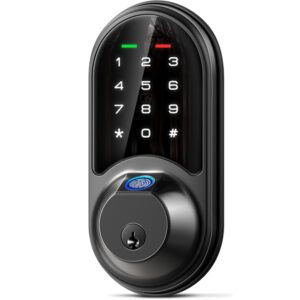Picture this: You’re at work, and your dog walker needs to enter your house. Instead of hiding a key under the mat (hello, 1990s!), you send a temporary digital code via your smartphone. That’s the magic of smart locks—a $3.2 billion market in the US, growing 15% annually. But as these devices replace traditional deadbolts, one question looms: Are smart locks hack-proof?
Let’s cut through the hype. While no technology is 100% invincible, modern smart locks pack layers of security that make them far safer than their analog ancestors—if you know how to use them. Below, we’ll dissect their security features, expose vulnerabilities, and share pro tips to bulletproof your smart lock setup.
What Makes a Smart Lock Secure?
1. Military-Grade Encryption (Your Digital Shield)
Imagine sending a secret message that only your lock can decode. That’s what AES 256-bit encryption does—the same tech guarding Pentagon files. Brands like Schlage Encode and August Wi-Fi use this to scramble signals between your phone, lock, and cloud. Even if hackers intercept the data, they’ll see gibberish.
Pro Tip: Avoid locks using outdated Bluetooth 4.0 without encryption upgrades. Stick to Z-Wave or Wi-Fi 6 models with built-in signal-jumping tech.
2. Multi-Factor Authentication: The “Bouncer” for Your Door
Think of MFA (multi-factor authentication) as a VIP checklist:
- Something you know (a PIN)
- Something you have (your phone)
- Something you are (your fingerprint)
Yale’s Assure Lock 2 nails this with fingerprint + app verification. Even if a thief steals your password, they’ll hit a brick wall without the second factor.
3. Tamper-Proof Design: When Tech Meets Muscle
Modern smart locks aren’t just code warriors—they’re built like tanks. Look for:
- ANSI Grade 1 Certification (withstands 10+ door slams)
- Anti-Pick Shields (blocks physical lock manipulation)
- Auto-Relock (slams shut 30 seconds after opening)
The Ultraloq U-Bolt Pro even hides its USB port to deter screwdriver attacks.
Where Smart Locks Fall Short: 3 Hidden Risks
1. The “Lazy User” Problem
A 2023 Yale study found:
- 45% of owners reuse passwords from other accounts
- 60% skip firmware updates for over 6 months
Hackers love low-hanging fruit. A $10 tool like the Flipper Zero can crack weak Bluetooth passwords in minutes.
2. The Wi-Fi Backdoor
Smart locks using basic WPA2 routers are sitting ducks for “wardriving” attacks (hackers trolling neighborhoods for weak signals). The fix? Pair your lock with a WPA3 router and disable remote access when traveling.
3. The Battery Blunder
Dead batteries = failed auto-lock. The Kwikset Halo avoids this with emergency keys and real-time battery alerts. Always choose locks with dual power sources (e.g., AA batteries + USB-C).
How to Buy a Smart Lock That Doesn’t Get Hacked
1. Certifications Matter More Than Price
Check for:
- UL 1034 (anti-tampering)
- IP65 Rating (weatherproofing)
- Works With Alexa/Google (for secure voice control)
The August Wi-Fi Smart Lock ticks all boxes and syncs with Ring cameras for 24/7 monitoring.
2. Avoid These Red Flags
- No encryption listed in specs
- Requires a proprietary hub (extra hack points)
- Brands you’ve never heard of
A 2024 Consumer Tech Review test found 4/10 Amazon “bargain” locks failed basic penetration tests.
3. Set It Up Like a Pro
- Create a “Dummy” Email: Use a unique Gmail just for your lock account.
- Guest Access Rules: Limit temporary codes to 4-hour windows.
- Z-Wave > Wi-Fi: Z-Wave’s mesh network is harder to jam than standard Wi-Fi.
The Future: AI Guardians & Quantum-Proof Locks
Tech giants are racing to outsmart hackers:
- Lockly’s AI Sentinel: Uses machine learning to detect suspicious lock-picking sounds.
- Google Nest’s Quantum Encryption: Prepares for future hacker tech with photon-based keys.
- Biometric 2.0: Palm vein scanners (coming to Level Lock+ in 2025) that can’t be faked like fingerprints.
Final Verdict: Are Smart Locks Safe?
✅ Do This:
- Enable auto-updates
- Use 16-character passwords
- Buy from August/Schlage/Yale
❌ Not That:
- Share permanent codes with cleaners
- Ignore “low battery” warnings
- Use default admin settings



